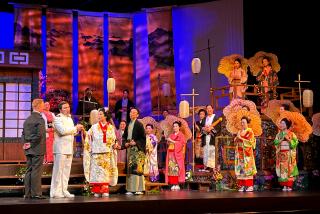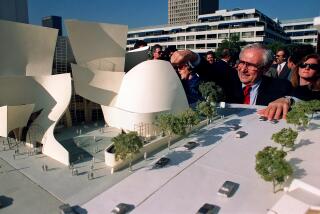A ‘Rite of Spring’ that Nijinsky and Stravinsky would recognize
When the Joffrey Ballet debuted its reconstructed “The Rite of Spring” in Los Angeles in fall 1987, it received a seismic welcome — a 5.9 on the Richter scale, to be exact.
The morning after “Rite’s” opening at the Music Center, a major earthquake struck Southern California. The Whittier Narrows quake, with an epicenter in the San Gabriel Valley, shook buildings in downtown L.A. and could be felt as far away as Las Vegas.
The Oct. 1 temblor caused widespread damage in the area, though no subsequent performances of “Rite” were canceled by the Joffrey, then a resident company at the Music Center.
PHOTOS: Arts and culture in pictures
For those involved with the production, the quake seemed to confirm a long-held historical belief: Wherever the “Rite” goes, major upheaval follows. This week, it returns to the city that has a long association with the music and its composer.
“The Rite of Spring,” which composer Igor Stravinsky debuted in Paris in 1913 with the Ballets Russes, celebrates its 100th anniversary this year. The piece, whose French title is “Le Sacre du Printemps,” is widely regarded as one of the most important ballets of the 20th century.
But in the annals of world premieres, the “Rite” debut on May 29, 1913, was probably the most inauspicious opening in ballet history.
Angry patrons — bewildered by Stravinsky’s strange music and maybe more so by Vaslav Nijinsky’s primitive choreography — famously rose up in rebellion several minutes into the performance. Punches were thrown. The police were called in.
History books quote one attendee, artist Valentine Gross Hugo, recalling that “it was as if the theater had been shaken by an earthquake.”
Stravinsky would write in his memoirs that the public rejection, which he described as “a terrific uproar,” was too much for him to bear. A few days later, he came down with typhoid and ended up in a nursing home for six weeks.
In the 100 years since it debuted, “Rite” has gone from being controversial to being widely performed, and it is usually presented as an orchestral work. It became a trademark piece for the Los Angeles Philharmonic under then-music director Esa-Pekka Salonen, who programmed the “Rite” for the inaugural concert at Walt Disney Concert Hall in 2003.
“It’s one of the very rare works of art that seems eternally young. It hasn’t lost any of its power or freshness or shock value,” said Salonen, on the phone from London, where he is principal conductor of the Philharmonia Orchestra.
IGOR STRAVINSKY: Composer’s connection to Los Angeles
The centenary of “Rite” will see festivals and celebrations in honor of Stravinsky around the world. Starting Friday, the Music Center will commemorate the anniversary with the Joffrey’s touring revival of its landmark 1987 “Rite,” which was the first major attempt to replicate Nijinsky’s lost choreography.
Based on meticulous research, the Joffrey’s staging tries to create what audiences in Paris experienced in 1913 minus the cracked monocles and trampled evening gowns. The Music Center also will present a festival devoted to “Rite” spread over several months that will include recitals, lectures and an exhibition.
As part of the festival, the Music Center will host a large-scale digital installation called “Re-Rite” from the Philharmonia Orchestra in August. The installation, at the Dorothy Chandler Pavilion, will simulate the experience of sitting in the orchestra, led by Salonen, as it performs the piece.
“Rite” — both music and dance — evokes pagan rituals from medieval Russia and is divided into two parts: “The Adoration of the Earth” centers on the celebration of spring, while “The Sacrifice” follows a virginal girl, known as the Chosen One, who dances herself to death in the ballet’s climax.
The controversy surrounding “Rite” didn’t last long. Seven years after it premiered, the Ballets Russes presented a new production with choreography by Léonide Massine and financed by fashion designer Coco Chanel. It was a success.
Twenty years later, “Rite” had become sufficiently mainstream that Walt Disney used the piece for the dinosaur sequence in the 1940 animated feature “Fantasia.”
“Rite” is arguably Stravinsky’s most famous work. Other choreographers who have created their distinctive “Rite” productions include Martha Graham, Pina Bausch and Maurice Béjart.
Still, today “Rite” has “extreme importance in the dance world,” said Tamara Levitz, a professor of musicology at UCLA.
MARILYN HORNE: Stravinsky and me
As an orchestral work, she said it remains “iconic” even though it has become something of a concert war horse, “the equivalent of ‘All You Need Is Love’ by the Beatles.”
‘Rite’ in L.A.
Los Angeles holds a special place in “Rite” history — and not just because the Russian-born Stravinsky lived here for nearly 30 years starting in 1940.
The L.A. Philharmonic first performed “Rite” in 1928 at the Hollywood Bowl under conductor Eugene Goossens. The orchestra has performed the piece more than 100 times, most recently in September, with music director Gustavo Dudamel.
In July 1962, Stravinsky conducted a concert of his own music at the Bowl, including selections from “The Firebird.” But the 80-year-old composer allowed his longtime colleague Robert Craft to lead the orchestra in “Rite” that evening.
The Joffrey’s 1987 staging in L.A. was the result of research conducted over 16 years by dance experts Millicent Hodson and Kenneth Archer, who traveled the globe hunting down first-hand testimony and documentation of the original performance.
“People would tell us that we were crazy,” recalled Hodson, speaking from the London home she shares with Archer. “There were a lot of dead-ends.”
Major ballet companies today employ choreologists to notate each dancer’s moves, but most documentation for Nijinsky’s choreography has been lost.
The couple said they received guidance from Marie Rambert, Nijinsky’s rehearsal assistant, who died in 1982 at age 94.
Their travels took them as far as India to search for the original costume designs by Nicholas Roerich, who spent the last years of his life in Himachal Pradesh state.
Archer said he eventually tracked down 80% of the costumes, scattered all over the world. Some were in museums, others were in Sweden. One costume ended up in the closet of actress Vanessa Redgrave, who liked to wear it to parties, Archer said.
Some lines of inquiry yielded unexpected results. The couple said they tracked down an oboist, Louis Speyer, who performed in the 1913 production. He told them his back was turned toward the stage so he never saw the choreography.
But Speyer recalled hearing a lot of noise from the dancers in the form of foot stomping and the slapping of hands. The clue led the Joffrey to incorporate more “body percussion” in its staging.
Dancers who perform the “Rite” describe it as an extremely difficult piece both technically and physically.
“It’s complicated for dancers to count — nothing is set numerically,” said Joanna Wozniak, a Joffrey dancer performing the role of the Chosen One. “You’re pretty dizzy and exhausted after it.”
The fatigue is different from the kind experienced in traditional ballet. “A lot of times in ballet you get winded, your breath is short and you start to lose some of the control in your legs. At the end of the Chosen One, it feels like your legs have melted beneath you,” said Anastacia Holden, another Joffrey dancer.
Martin Bernheimer, then The Times’ music and dance critic, deemed the 1987 debut an important milestone but added that “one often saw cautious correctness when one most wanted controlled abandon.”
The Joffrey’s “Rite” production has since been presented by companies around the world. (The Joffrey moved to Chicago in 1995.)
Stravinsky was clearly embittered by the calamitous world premiere in Paris. In his 1935 memoirs, he put a lot of the blame on Nijinsky, whose choreography he described as “a very labored and barren effort.”
The composer much preferred the later staging by Massine, writing that the new choreography (also now mostly lost to history) “was in perfect accord with the music.” He also thanked Chanel for “arranging to have the costumes made in her world-famous dressmaking establishment.”
Stravinsky is rumored to have had a brief affair with the designer, but it has never been proved. Their alleged liaison was the subject of the 2009 movie “Coco Chanel & Igor Stravinsky,” based on the novel by Chris Greenhalgh. The film begins with a full-scale depiction of the 1913 riot at the Théâtre des Champs-Élysées in Paris.
Other rumors and hypotheses have dogged “Rite” throughout the years. Some claim that the riot was aimed more at Nijinsky’s choreography than Stravinsky’s music. Some even believe that Sergei Diaghilev, the flamboyant director of the Ballets Russes, exaggerated the controversy for publicity.
Whether the conjectures are true or not, “we can’t minimize how radically different this musical language was,” said Patrick Scott, the head of the new music group Jacaranda. The group will present the arrangement of “Rite” for two pianists Feb. 23 in Santa Monica.
“Rite” is no longer controversial, but the Joffrey’s three performances Feb. 1-3 could still be earth-shattering, if only in the geological sense.
The Music Center, like much of downtown L.A., sits on top of the Puente Hills thrust fault, which is now believed to have created the 1987 quake.
According to a Times report, experts believe the fault has the potential to cause a magnitude-7.5 quake.
Celebrating Stravinsky and ‘Rite of Spring’
To celebrate the 100th anniversary of “The Rite of Spring,” the Music Center is presenting a festival dedicated to all things Stravinsky-related. All events will be held at the Dorothy Chandler Pavilion:
“The Rite of Spring”: The Joffrey Ballet presents its 1987 reconstruction of Stravinsky’s and Vaslav Nijinsky’s ballet, which debuted in 1913. (Feb. 1-3)
“Stravinsky and L.A. Dance”: An exhibition about Stravinsky and early L.A. dance pioneers, with photographs and other artifacts. (Feb. 1-17)
L.A.’s “Rite” symposium: Dance experts will hold a daylong series of public talks about the “Rite” and its historical importance. (Feb. 2)
“Apollo”: American Ballet Theatre will present George Balanchine’s classic take on Stravinsky’s “Apollo.” (July 11)
“Re-Rite”: A large-scale digital installation from London’s Philharmonia Orchestra that simulates the experience of sitting in the orchestra as it performs “Rite.” (Aug. 1-11)
“Chamber”: Nederlands Dans Theater will present “Chamber,” a new dance work inspired by “Rite.” The piece is co-commissioned by the Music Center. (Oct. 18-20)
Information: https://www.musiccenter.org
MORE
INTERACTIVE: Christopher Hawthorne’s On the Boulevards
VOTE: What’s the best version of ‘O Holy Night’?
PHOTOS: Arts and culture in pictures
More to Read
The biggest entertainment stories
Get our big stories about Hollywood, film, television, music, arts, culture and more right in your inbox as soon as they publish.
You may occasionally receive promotional content from the Los Angeles Times.











